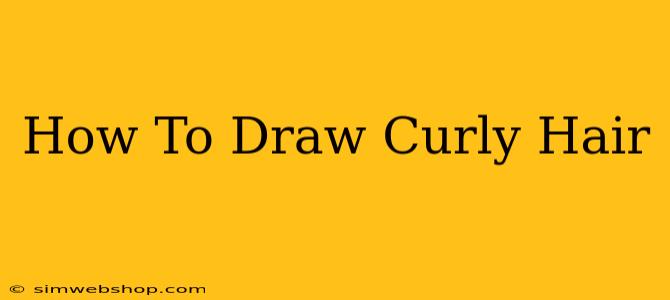Drawing curly hair can seem daunting, but with the right techniques and a little practice, you can master the art of portraying its beautiful texture and volume. This comprehensive guide will walk you through various methods, from simple to advanced, helping you achieve realistic and expressive curly hair in your drawings.
Understanding the Structure of Curly Hair
Before we dive into the drawing techniques, it's crucial to understand the unique characteristics of curly hair. Unlike straight hair, curly hair has a more defined S-shape or spiral pattern. The individual strands are often thicker and have a different light reflection compared to straight hair. This understanding will inform your shading and line work.
Key Characteristics to Observe:
- Curl pattern: Observe the specific curl type – loose waves, tight coils, or anything in between.
- Hair volume: Curly hair tends to have more volume, so consider this when defining the overall shape.
- Light reflection: Notice how light reflects differently on the curves and spirals of the hair.
Basic Techniques for Drawing Curly Hair
For beginners, starting with simplified forms is key to building confidence.
1. Using Simple Shapes:
Begin by sketching the overall shape of the curly hair using simple shapes like ovals, circles, and S-curves. These will form the foundation of your drawing and help you establish the direction and flow of the curls.
2. Defining the Curls:
Once you have the basic shapes, start adding details to define individual curls. Use flowing, continuous lines to create the S-shape or spiral pattern characteristic of curly hair. Don't be afraid to overlap lines to create depth and texture.
3. Adding Volume and Texture:
To make the hair look more realistic, add variation in the thickness of the lines. Some curls might be thicker, while others are thinner. You can also add subtle variations in the curl pattern to create a more natural look.
Advanced Techniques for Realistic Curly Hair
Once you feel comfortable with the basics, you can explore more advanced techniques to enhance realism and detail.
1. Shading and Light:
Shading is essential for creating depth and dimension in curly hair. Use different shades of your chosen medium to create highlights and shadows. Pay attention to where the light hits the curls and how it creates variations in tone and contrast. Highlight the outer edges of the curls for a glossy effect.
2. Strands and Separations:
To make the hair look more natural, add individual strands and separations between the curls. This creates a more textured and realistic look. Don't draw each strand perfectly, instead use subtle variations in thickness and length to add a sense of movement and flow.
3. Defining the Scalp:
Remember to show how the hair originates from the scalp. This helps to improve the natural look of your drawing.
Different Styles of Curly Hair
The techniques above can be adapted to various curly hairstyles:
- Afro: This style requires focusing on the volume and tightly packed curls.
- Bouncy curls: This requires depicting a lighter, springier curl pattern.
- Wavy hair: This requires a less defined curl, with a gentler wave pattern.
Practice Makes Perfect!
Drawing curly hair is a skill that improves with practice. Don't get discouraged if your first attempts aren't perfect. Experiment with different techniques, styles and mediums. The more you practice, the better you'll become at capturing the beauty and complexity of curly hair.
Resources and Inspiration
Seek inspiration from photos, real-life observations, and other artists' work. Online tutorials and workshops can provide further guidance. Remember, the key is to have fun and enjoy the creative process!

